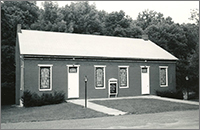 |
Continuing the work of Jesus Peacefully ~ Simply ~ Together |
Free Spring Church of the Brethren 670 Free Spring Church Road, Mifflintown (Van Wert), PA 17059 “Go therefore and make disciples of all nations” Matthew 28:19 |
HISTORY OF FREE SPRING
Free Spring Church is a part of the denomination called the Church of the Brethren, founded in 1708 by a small group of Anabaptists living in central Germany. Their leader Alexander Mack and seven others participated in believers' baptism through trine immersion. This early fellowship was also influenced by the Pietist Movement of the 17th Century. See resource links below.
After the Brethren immigrated to Pennsylvania, the Lost Creek Congregation was established near McAlisterville in 1790. By the time of the Civil War, a large number of Lost Creek members were living in the Van Wert area, so it was decided to erect another meeting house there. Brethren practiced baptism by immersion which encourage congregations to build meeting houses near streams. Many congregations contain the names of streams in their name: Lost Creek, Beaver Creek, Linville Creek, Mill Creek, Piney Creek, Blue River, Maple Spring, Roaring Spring, Snake Springs, and Three Springs to name a few.
Northwest of the village of Van Wert there were numerous springs, especially one of dependable strength, flowing when others had receded, with ample water for baptisms. Residents of the area knew of its special qualities. Passersby could take of its water "freely." Gradually it came to be known as the Free Spring. Predictably, the new meeting house became known as the "Free Spring" Church of the Brethren.
STRUCTURES
PASTORAL FAMILIES
The Lost Creek Congregation was founded in 1790 which originally included four meeting houses: Bunkertown, Free Spring, Richfield, and Oriental. Richfield was the first to depart from the Lost Creek Congregation around 1950 (now an apartment house next to the Guardian Angel Bookstore). Oriental also departed sometime in the late 1960s. Bunkertown and Free Spring remained together with one pastor, church board, and financial structure until 1980. Each single pastor would preach at one location while the other had Sunday School. Then he would drive to the second location for worship while the first had their Sunday School. For many years the services would rotate every week. One church would have worship first one week and then Sunday School first the next week.
Gradually a number of factors contributed toward more stress for the single pastor of two membership groups. For many decades the primary hospital for visitation was at Lewistown with rare occasions being Harrisburg. By the late 1970s there were six: Lewistown, Danville, Lewisburg, Holy Spirit, Harrisburg City, and Osteopathic. Each meeting-house gradually increased in membership which necessitated the pastor devoting more time for counseling and visitation. Preaching styles also changed and ten minutes was barely enough time for the pastor to drive to the second meeting-house. John & Peggy Layman were the last pastor and wife to fulfill these expectations. 1980 was the year for each member group to establish their own separate congregation. Woody & Nancy Johnson served Bunkertown with Keith & Beth Hollenberg serving at Free Spring.
BRETHREN BEGINNINGS
The Church of the Brethren originated in the village of Schwarzenau, a part of the Wittgenstein district of 17th Century Germany, under the protection of Count Henrich Albrecht's promise of refuge to all persons experiencing harm for religious beliefs or activities. Membership and attendance was mandatory at one of the three state churches of that time (Catholic, Lutheran, Reformed). Each faith in like manner baptized infants. Adult baptism was illegal and Anabaptists were the first to feel the sting of persecution. Alexander Mack and seven others baptized themselves in the Eder River near Schwarzenau. It was a difficult period for the early Brethren. They suffered from religious persecution as well as nearly everyone else in central Europe that was suffering in the devastating wake of the Thirty-Years War. Farm lands were repeatedly trampled by armies. Food was scarce and disease rapidly spreading. Brethren groups started leaving for the New World in the hope of freedom to baptize and worship as they pleased. Read the following separate histories of their journey of faith.
“Do not remove the ancient landmark which your fathers have set.”
Proverbs 22:28














